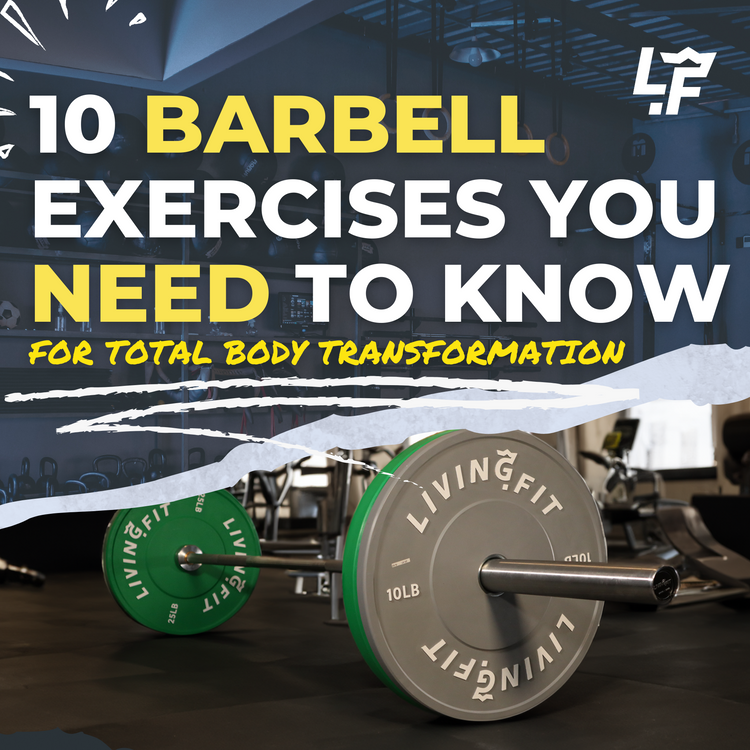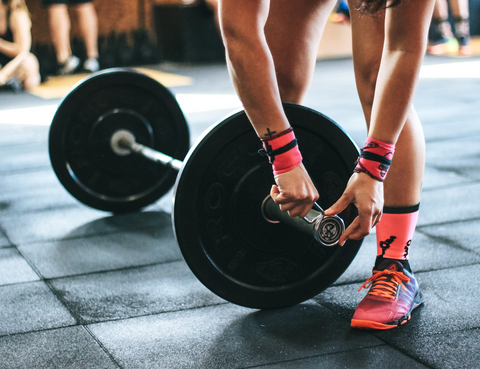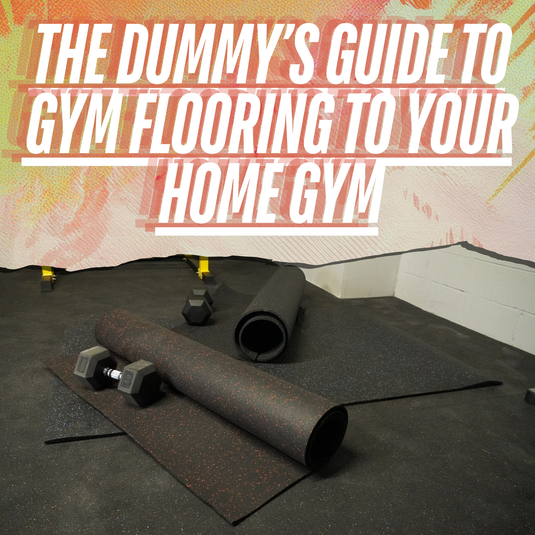10 Barbell Exercises for Total Body Transformation

⏱️ Estimated Read Time: 6 minutes
🧠 TL;DR
- 10 Barbell Exercises for Total Body Transformation offers effective, accessible movements for targeted results.
- This guide is designed to help you move smarter, build strength, and stay consistent.
✍️ Summary
This post explores 10 barbell exercises for total body transformation in a way that’s actionable and easy to follow. Whether you're new to this style of training or leveling up, it includes practical takeaways for your routine.
📚 Table of Contents
Barbells, the quintessential strength training tools, have been integral to fitness routines for decades. These versatile pieces of equipment are not just metal bars with weights; they represent a pathway to achieving strength, muscle gains, and overall fitness. Barbell exercises have been integral components of strength training routines for decades. Barbells serve as fundamental tools in resistance training, offering various exercises to target multiple muscle groups. From compound movements like squats, deadlifts, and bench presses to isolation exercises such as bicep curls and skull crushers, the versatility of barbells allows for a comprehensive strength training regimen.
In this guide, we'll explore barbell exercises, their definitions, how to incorporate them effectively into workouts, and the myriad benefits they offer.
What Are Barbells?

Barbells are long metal bars with weights attached to either end, designed for strength training exercises. Typically, barbells come in standard lengths and weights, although variations exist to suit individual needs and preferences. The weights, known as plates or discs, are slid onto the ends of the barbell and secured with collars to prevent them from slipping off during exercise. Barbells allow for a wide range of movements. They can be used for compound exercises, which engage multiple muscle groups simultaneously, and isolation exercises, which target specific muscles.
One of the critical advantages of barbells is their adaptability to various movements and training styles. Whether aiming to build overall strength, increase muscle mass, or improve athletic performance, barbells offer many options to cater to your specific goals. Compound exercises like squats, deadlifts, and overhead presses utilize the entire body, making them highly efficient for developing functional strength and power. On the other hand, isolation exercises such as bicep curls and tricep extensions allow for targeted muscle engagement, enabling you to address specific areas of weakness or imbalance.
Why Incorporate Barbell Exercises In Your Workout Regimen?
Incorporating barbell exercises into your workout regimen offers many benefits that can significantly enhance your fitness journey. Here's a detailed explanation of why you should consider adding barbell training to your routine:
Maximized Muscle Engagement
Barbell exercises often involve compound movements that engage multiple muscle groups simultaneously. For example, exercises like squats, deadlifts, and bench presses recruit the primary muscles targeted and stabilizer muscles throughout the body. This comprehensive activation leads to efficient muscle growth and development across various body areas.
Strength and Power Development
Due to their design and stability, barbells allow you to lift heavier weights than other types of equipment. This capacity for heavy loading is essential for stimulating strength and power gains. By progressively overloading the muscles with increasing resistance, you can continually challenge your strength thresholds, improving overall power and force production.
Functional Fitness
Many barbell exercises mimic our natural, functional movements in daily life or athletic activities. For instance, a deadlift replicates lifting a heavy object from the ground. At the same time, a squat mirrors the movement of sitting down and standing up. By training these fundamental movement patterns with barbells, you can improve your functional fitness, making daily tasks easier and reducing the risk of injury during physical activities.
Muscle Hypertrophy
If your goal is to build muscle mass and achieve a more aesthetic physique, barbell exercises are efficient. These movements create significant mechanical tension and muscle damage, critical factors in stimulating muscle hypertrophy (growth). By consistently challenging your muscles with heavy resistance through exercises like barbell curls, rows, and presses, you can promote muscle growth and achieve a more muscular, defined physique over time.
Improved Bone Health
Weight-bearing exercises, such as those performed with barbells, benefit bone health. The stress placed on the bones during resistance training stimulates the production of new bone tissue, increasing bone density and strength, which is particularly beneficial for preventing osteoporosis and reducing the risk of fractures, especially as you age.
Metabolic Boost and Fat Loss
High-intensity resistance training with barbells has been shown to increase metabolic rate both during and after exercise. This post-exercise metabolic boost, often referred to as excess post-exercise oxygen consumption (EPOC), can lead to enhanced calorie burning and fat loss over time. Additionally, building lean muscle mass through barbell training can further support fat loss efforts by increasing overall energy expenditure.
In conclusion, incorporating barbell exercises into your workout regimen offers a wide array of benefits that cater to various fitness goals, whether you're aiming to build strength, increase muscle mass, improve functional fitness, or enhance overall health and well-being. By leveraging the versatility and effectiveness of barbell training, you can maximize your fitness potential and achieve remarkable results in your fitness journey.
10 Barbell Exercises You Must Know !
Here are 10 essential barbell exercises along with instructions and benefits for each. All sets and reps recommended are with a focus on strength as the primary adaptation:
Barbell Squat
The barbell squat, a crucial foundational compound exercise, is designed to target the lower body, including the quadriceps, hamstrings, glutes, and lower back
How to Do It
- Start by standing with feet shoulder-width apart, holding the barbell across your upper back.
- Lower your body by bending your knees and hips, keeping your chest up and back straight.
- Descend until your thighs are parallel to the ground, then push through your heels to return to the starting position.
- Aim for 3-4 sets of 6-8 reps.
Benefits
- Builds strength and muscle mass in the lower body.
- Improves core stability and overall functional movement patterns.
Barbell Deadlift
The barbell deadlift is a fundamental compound exercise that primarily targets the posterior chain muscles, including the hamstrings, glutes, and lower back.
How to Do It
- Begin with feet hip-width apart, with a barbell on the ground in front of you.
- Bend at the hips and knees, keeping your back flat and chest up, and grip the barbell with hands shoulder-width apart.
- Lift the barbell by extending your hips and knees until you are standing upright, then lower it with control.
- Aim for 3-4 sets of 5-8 reps.
Benefits
- Promotes overall strength and power development.
- Targets multiple muscle groups simultaneously for efficient training
Barbell Bench Press
The barbell bench press is a classic upper-body exercise that primarily targets the chest, shoulders, and triceps.
How to Do It
- Lie flat on a bench with the barbell racked above your chest.
- Grip the barbell slightly wider than shoulder-width apart, lower it to your chest, and then press it upwards until your arms are fully extended.
- Lower the barbell back down with control.
- Aim for 3-4 sets of 5-8 reps..
Benefits
- Builds strength and muscle mass in the chest, shoulders, and triceps.
- Enhances upper body pushing strength and power.
Barbell Push Press
The barbell push press is a compound exercise that targets the shoulders, triceps, and upper body while engaging the core and lower body for stability and power.
How to Do It
- Begin by standing with feet shoulder-width apart, holding the barbell in front of your shoulders with an overhand grip.
- Bend your knees slightly to create momentum, then explosively push the barbell overhead by extending your arms and legs simultaneously.
- Fully extend your arms at the top of the movement, then lower the barbell back down to shoulder height with control.
- Maintain a stable core and avoid excessive lower back arching throughout the exercise.
- Aim for 3-4 sets of 6-8 reps.
Benefits
- Builds shoulder strength and muscle mass, particularly in the deltoid muscles.
- Enhances upper body pushing power and strength.
- Improves overall athleticism and explosiveness.
- Engages the core and lower body for stability and coordination.
- It can be incorporated into various workout routines for increased muscle development and functional strength.
Barbell Overhead Press
The barbell overhead press is a compound exercise that primarily targets the shoulders, triceps, and upper chest.
How to Do It
- Stand with feet hip-width apart, holding the barbell at shoulder height with an overhand grip.
- Press the barbell overhead until your arms are fully extended, then lower it back down to shoulder height.
- Keep your core engaged, and avoid arching your lower back.
- Aim for 3-4 sets of 6-8 reps.
Benefits
- Builds shoulder strength and muscle mass.
- Improves overhead pressing strength and stability.
Barbell Bent-Over Row
The barbell bent-over row is an effective compound exercise for targeting the back muscles, including the lats, rhomboids, and traps.
How to Do It
- Stand with your feet hip-width apart, holding the barbell with an overhand grip, palms facing down.
- Hinge at the hips and bend your knees slightly, keeping your back flat and chest up.
- Pull the barbell towards your lower chest, squeezing your shoulder blades together at the movement's top.
- Lower the barbell back down to the starting position in a controlled manner.
- Aim for 3-4 sets of 6-8 reps.
Benefits
- Builds upper back strength and muscle mass.
- Improves posture and spinal alignment.
- Enhances grip strength and forearm development.
Barbell Romanian Deadlift
The barbell Romanian deadlift targets the hamstrings, glutes, and lower back while placing less stress on the knees than traditional deadlift variations.
How to Do It
- Stand with feet hip-width apart, holding the barbell in front of your thighs with an overhand grip.
- Keep your chest up and shoulders back as you hinge at the hips, lowering the barbell towards the ground while maintaining a slight bend in the knees.
- Lower the barbell until you feel a stretch in your hamstrings, then return to the starting position by driving your hips forward.
- Aim for 3-4 sets of 8-10 reps.
Benefits
- Strengthens the posterior chain muscles.
- Improves hip hinge mechanics and hamstring flexibility.
Barbell Pullover
The barbell pullover is a classic exercise that primarily targets the back, chest, and arm muscles while also engaging the core for stability.
How to Do It
- Lie flat on a bench with your upper back supported and your feet firmly planted.
- Hold the barbell with an overhand grip, arms fully extended above your chest.
- Lower the barbell in a controlled manner behind your head, keeping your arms slightly bent.
- Pause briefly once you feel a stretch in your chest and lats, then contract the chest and lats to return to the starting position.
- Keep your core engaged, and avoid arching your back excessively throughout the movement.
- Aim for 3-4 sets of 6-8 reps.
Benefits
- Targets the upper back muscles, including the latissimus dorsi and rhomboids, as well as the chest and triceps.
- Improves shoulder mobility and flexibility.
- Enhances overall upper body strength and muscle definition.
- Engages the core muscles for stability and balance.
- It can be used as a supplementary exercise to increase muscle hypertrophy and strength in the upper body.
Barbell Hip Thrust
The barbell hip thrust is excellent for targeting the glutes and hamstrings while engaging the core muscles.
How to Do It
- Sit on the ground with your upper back against a bench, knees bent, and feet flat on the floor.
- Place the barbell across your hips and roll it towards your body.
- Drive through your heels and lift your hips towards the ceiling, squeezing your glutes at the top of the movement.
- Lower your hips back down with control, and repeat.
- Aim for 3-4 sets of 6-8 reps.
Benefits
- Builds strong and shapely glutes.
- Improves hip extension strength and power.
Barbell Curl
The barbell curl is a classic bicep exercise that isolates and strengthens the muscles on the front of the upper arm.
How to Do It
- Stand with feet hip-width apart, holding the barbell with an underhand grip, hands shoulder-width apart.
- Keep your elbows close to your body as you curl the barbell towards your shoulders, squeezing your biceps at the top of the movement.
- Lower the barbell back down to the starting position in a controlled manner.
- Aim for 3-4 sets of 6-8 reps.
Benefits
- Builds size and definition in the biceps.
- Enhances arm strength and aesthetics.
By incorporating these barbell exercises strategically into your workout routine and progressively challenging yourself over time, you can unlock your full potential and achieve remarkable results in strength, muscle growth, and overall physical fitness.
Essential Considerations and Precautions
Before engaging in barbell exercises, it's essential to consider several factors to ensure a safe and effective workout experience. Here are some key things to keep in mind and safety precautions to take:
Consult with a Healthcare Professional.
Suppose you have any pre-existing medical conditions or concerns. In that case, it's advisable to consult with a healthcare professional before starting a barbell training program. They can provide personalized advice based on your health status and fitness goals.
Learn Proper Form
Before attempting any barbell exercises, take the time to learn the correct form and technique for each movement. Improper form not only diminishes the exercise's effectiveness but also increases the risk of injury. Consider working with a qualified fitness trainer or coach to ensure you're performing exercises safely and efficiently.
Start with Lighter Weights.
Regardless of your fitness level, start with lighter weights when beginning a new barbell exercise or if you're unfamiliar with a particular movement. Gradually increase the weight as you become more comfortable and confident with the exercise, ensuring you maintain proper form throughout the entire range of motion.
Warm-Up Properly
Before starting your barbell workout, warm up your muscles with dynamic movements such as jogging, jumping jacks, or bodyweight exercises. A thorough warm-up increases blood flow to the muscles, improves flexibility, and prepares your body for the demands of lifting weights.
Use Appropriate Equipment
Ensure you're using the correct type of barbell and weights for your workout. Check the condition of the equipment for any signs of damage or wear and tear, and ensure it's securely assembled and stable before lifting. Use collars to prevent the weights from sliding off the barbell during exercise.
Practice Safety Measures
Always exercise in a safe and controlled environment, such as a gym with proper flooring and equipment. Clear the surrounding area of any obstacles or hazards that could pose a tripping or falling risk. Additionally, consider using a spotter, especially when performing heavy lifts like squats or bench presses, to assist if needed.
Listen to Your Body
Pay attention to how your body feels during exercise. Stop immediately if you experience any pain or discomfort beyond normal muscle fatigue. Pushing through pain can lead to injury, so knowing and respecting your limits is essential. If you need help deciding whether to continue, avoid caution and seek guidance from a fitness professional.
Stay Hydrated and Nourished.
Drink plenty of water before, during, and after your workout to stay hydrated, especially when performing intense barbell exercises that cause sweating. Additionally, fuel your body with a balanced diet of protein, carbohydrates, and healthy fats to support muscle recovery and growth.
By considering these factors and implementing safety precautions, you can minimize the risk of injury and maximize the benefits of your barbell workouts. Remember that consistency, patience, and proper technique are key to achieving long-term strength training and fitness success.
Integrating Barbell Workouts for Optimal Fitness Results

Incorporating barbell exercises into your workout routine is a powerful way to boost strength, muscle development, and overall fitness. Start by defining your fitness goals and assessing your experience level. Beginners should focus on mastering proper form with lighter weights, while experienced lifters can diversify their routines with various exercises.
- Define fitness goals and assess experience level; understand what you want to achieve and where you stand regarding familiarity with barbell exercises.
- Focus on mastering proper form: Beginners should prioritize learning the correct technique with lighter weights to prevent injuries and lay a solid foundation.
- Incorporate compound movements, such as squats, deadlifts, bench presses, and rows, to engage multiple muscle groups for efficient workouts.
- Target all major muscle groups, and ensure your workout plan covers the upper body, lower body, and core to promote balanced strength development.
- Gradually increase intensity and complexity. Progressively challenge yourself by adding weight, adjusting reps and sets, or trying advanced variations of exercises.
- Prioritize safety and warm-up. Always warm up before lifting, use proper lifting techniques, and listen to your body to prevent injuries and promote longevity in training.
- Seek guidance if needed. Consider working with a certified trainer or coach to learn proper form and receive personalized advice tailored to your goals and abilities.
- Listen to your body, Recognize signs of fatigue, discomfort, or pain, and adjust your workouts to avoid overtraining and injury.
- Stay consistent. Stick to your workout schedule, track your progress, and adjust your routine as needed to keep making gains and staying motivated.
Beginner to Intermediate Barbell Workout Plan
Day 1: Full-Body Workout
- Barbell Squat: 3 sets of 6-8 reps
- Barbell Bench Press: 3 sets of 8-10 reps
- Barbell Bent-Over Row: 3 sets of 8-10 reps
- Barbell Romanian Deadlift: 3 sets of 8-10 reps
- Barbell Russian Twist: 3 sets of 10-15 reps per side
Day 2: Rest or Active Recovery
Day 3: Upper Body Focus
- Barbell Bench Press: 4 sets of 8-10 reps
- Barbell Overhead Press: 4 sets of 6-8 reps
- Barbell Bent-Over Row: 4 sets of 8-10 reps
- Barbell Curl: 3 sets of 8-12 reps
Day 4: Lower Body Focus
- Barbell Deadlift: 4 sets of 5-8 reps
- Barbell Squat: 4 sets of 6-8 reps
- Barbell Lunges: 3 sets of 8-12 reps per leg
- Barbell Hip Thrust: 3 sets of 10-12 reps
Day 5: Rest or Active Recovery
Day 6: Full-Body Strength
- Barbell Squat: 4 sets of 6-8 reps
- Barbell Bench Press: 4 sets of 8-10 reps
- Barbell Bent-Over Row: 4 sets of 8-10 reps
- Barbell Romanian Deadlift: 4 sets of 8-10 reps
- Barbell Russian Twist: 3 sets of 10-15 reps per side
Day 7: Rest and Recovery
Week 2: Intermediate to Advanced Barbell Workout Plan
Day 1: Full-Body Strength
- Barbell Squat: 4 sets of 8-10 reps
- Barbell Bench Press: 4 sets of 8-10 reps
- Barbell Bent-Over Row: 4 sets of 8-10 reps
- Barbell Romanian Deadlift: 4 sets of 8-10 reps
- Barbell Russian Twist: 3 sets of 10-15 reps per side
Day 2: Rest or Active Recovery
Day 3: Upper Body Strength
- Barbell Bench Press: 4 sets of 8-10 reps
- Barbell Overhead Press: 4 sets of 6-8 reps
- Barbell Bent-Over Row: 4 sets of 8-10 reps
- Barbell Curl: 3 sets of 8-12 reps
Day 4: Lower Body Strength
- Barbell Deadlift: 4 sets of 6-8 reps
- Barbell Squat: 4 sets of 8-10 reps
- Barbell Lunges: 3 sets of 8-12 reps per leg
- Barbell Hip Thrust: 3 sets of 10-12 reps
Day 5: Rest or Active Recovery
Day 6: Full-Body Hypertrophy
- Barbell Squat: 4 sets of 10-12 reps
- Barbell Bench Press: 4 sets of 10-12 reps
- Barbell Bent-Over Row: 4 sets of 10-12 reps
- Barbell Romanian Deadlift: 4 sets of 10-12 reps
- Barbell Russian Twist: 3 sets of 12-15 reps per side
Day 7: Rest and Recovery
This two-week workout plan progressively increases in intensity and volume, catering to beginner, intermediate, and advanced levels. Adjust weights and rest times, and prioritize proper form and technique.
Conclusion
Barbell exercises have proven indispensable tools for strength training and fitness. Their versatility and effectiveness offer a pathway to achieving strength, muscle gains, and overall wellness. From compound movements targeting multiple muscle groups to isolation exercises focusing on specific areas, barbell training provides a comprehensive approach to strength development.
By incorporating barbell exercises into your workout routine, you can maximize muscle engagement, strength and power development, functional fitness, muscle hypertrophy, bone health, metabolic boost, and injury prevention. With proper form, safety precautions, and consistency, you can reap the numerous benefits of barbell training while minimizing the risk of injury.
Whether you're a beginner looking to establish a solid foundation or an experienced lifter aiming to diversify your routine, barbell exercises offer endless possibilities for achieving your fitness goals. With the proper guidance and programming, you can unleash your full potential and achieve remarkable results in your fitness journey. So grab a barbell, set your goals, and journey to a stronger, healthier you.
Helpful Resources:
- Be alerted when we publish more like this to our blog here
- Download our app here
- Daily workout plans here
- Fitness Equipment like barbells and bumper plates here
- Free bodyweight workouts here
Want more guidance? Check out our Weekly Dumbbell Workout #1.
📝 FAQs
How often should I do these exercises? +
2–3 times per week is a good starting point for most people.
Do I need equipment? +
Many of these can be done with just your bodyweight or a single kettlebell or dumbbell.
Can beginners do these routines? +
Yes! These movements are designed to scale with your fitness level.




